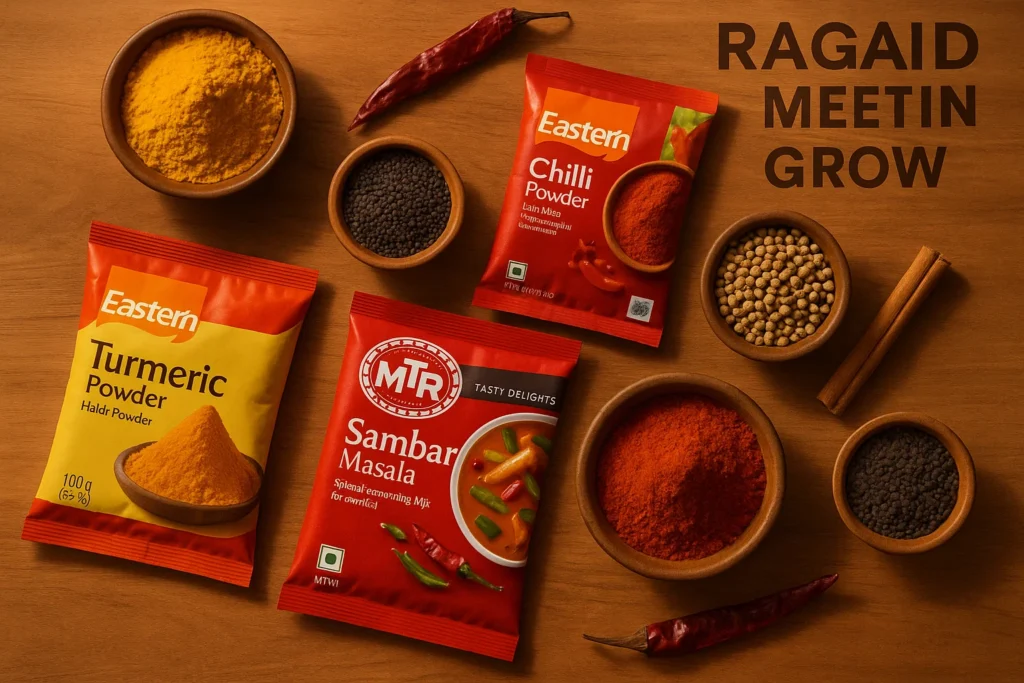Orkla India IPO 2025
The Orkla India IPO marks one of the most awaited entries in India’s FMCG space, combining regional strength, legacy brands, and exceptional financial performance.
The parent company of iconic South Indian food brands MTR Foods and Eastern Condiments, Orkla India Limited is preparing for its initial public offering (IPO) scheduled to open on October 29, 2025, and close on October 31, 2025.
The company filed its Red Herring Prospectus (RHP) on October 23, 2025, with the Securities and Exchange Board of India (SEBI), targeting a valuation of approximately ₹10,000 crore at the upper end of its price band.
Orkla India operates as a wholly-owned subsidiary of Orkla ASA, a Norway-listed industrial investment company. Its current ownership structure includes Orkla Asia Pacific Pte Ltd (90%), Navas Meeran (5%), and Feroz Meeran (5%).
Following the IPO, promoter holding will reduce from 90% to 75%, as the entire issue is an Offer for Sale (OFS) of 22,843,004 equity shares.
Dual-Brand Strategy: MTR and Eastern
The company’s business model follows a dual-brand architecture designed to optimize market coverage across consumer segments and regional preferences.
MTR Foods, founded in 1924, is an authentic vegetarian brand known for its ready-to-cook (RTC), ready-to-eat (RTE), and breakfast mix products. It holds a strong heritage in Karnataka and Andhra Pradesh.
Eastern Condiments, established in 1983 and acquired by Orkla in March 2021 for approximately NOK 2.4 billion (₹2,000 crore), focuses on Kerala’s non-vegetarian spice market. The acquisition strengthened Orkla’s position in South India and diversified its spice portfolio.
Product Portfolio and Revenue Mix
As of June 2025, Orkla India offers around 400 SKUs, selling approximately 2.3 million units daily. The company’s revenue mix consists of 65–67% spices and 33–35% convenience foods, with plans to shift towards a more balanced 65:35 mix favoring convenience foods.
Key product categories include:
- Spices: blended masalas like Sambar, Chicken, Rasam, and Biryani; pure spices such as Chilli, Turmeric, and Coriander.
- Convenience foods: RTC mixes (Rava Idli, Poha), RTE products (Gulab Jamun, sweets), breakfast solutions (3-Minute range), vermicelli, and beverages.
Manufacturing and Supply Chain Infrastructure
Orkla India’s capital-efficient production model provides scale and flexibility. It operates nine manufacturing facilities across India, with a total installed capacity of 182,270 tonnes per annum (TPA). Eight of these are located in South India to ensure proximity to raw material sources and key markets.
Additionally, the company works with 21 contract manufacturers (18 in India and 3 overseas in UAE, Thailand, and Malaysia), maintaining agility and risk diversification. All facilities hold international certifications such as BRCGS and ISO 22000, ensuring high food safety standards.
The company manages 2 central distribution centers and 20 regional warehouses covering 348,640 sq. ft., primarily on a leased model for capital efficiency.
Distribution Network and Market Reach
Orkla India boasts one of South India’s most extensive FMCG networks, comprising 834 distributors and 1,888 sub-distributors across 28 states and 6 union territories, reaching approximately 690,000 retail outlets, with 80% concentrated in Karnataka and Kerala.
The company’s brands have exceptional reach—MTR covers 67.5% of outlets in Karnataka, while Eastern reaches 70.4% of Kerala’s outlets, far surpassing the 30–40% industry average.
Modern trade contributes 13.2% of total sales through partnerships with 42 retail chains, including Reliance Retail and Big Basket.
E-commerce and quick commerce channels, active on six platforms, have grown over 40% year-on-year, contributing 7.5% of FY2025 revenues, doubling between FY2023 and FY2025.
Internationally, Orkla India exports to 45 countries, with 70% of exports to GCC nations, 20% to North America, and the rest to diaspora markets. Export revenue reached ₹486.17 crore in FY2025, up from ₹370 crore in FY2023, reflecting a 15% CAGR and a 22.2% share in India’s branded spice export segment.
Market Position and Competitive Strengths
According to the Technopak Report cited in the RHP, Orkla India ranks among the top four companies in terms of revenue from spices and convenience food operations in FY2024. It dominates key southern markets with a 31% market share in Karnataka and 42% in Kerala, with MTR and Eastern present in 9 out of 10 households in these states.
Competitive strengths include:
- Deep regional expertise and authentic formulations
- Strong brand heritage: MTR (100 years) and Eastern (40 years)
- Capital-efficient operations with ROCE of 32.7% and a debt-free balance sheet
- Access to Orkla ASA’s global R&D and management resources
- Internationally certified facilities, enhancing export credibility
Financial Performance Overview
Over the last three fiscal years, Orkla India has maintained consistent growth in both revenue and profitability, while keeping its debt levels negligible. Despite temporary margin compression in FY2024, the company regained momentum in FY2025 with stronger EBITDA margins and improving returns.
Here’s a closer look at Orkla India’s key financial metrics:
| Metric | FY2023 | FY2024 | FY2025 |
|---|---|---|---|
| Revenue (INR Cr) | 2,201.44 | 2,387.99 | 2,455.24 |
| EBITDA (INR Cr) | 316.54 | 343.61 | 396.44 |
| PAT (INR Cr) | 339.13 | 226.33 | 255.69 |
| Total Assets (INR Cr) | 3,101.96 | 3,375.19 | 3,171.30 |
| Net Worth (INR Cr) | 2,237.69 | 2,201.48 | 1,853.47 |
| Total Debt (INR Cr) | 34.99 | 3.77 | 2.33 |
| EBITDA Margin (%) | 14.4 | 14.6 | 16.6 |
| PAT Margin (%) | 15.6 | 9.6 | 10.7 |
| ROCE (%) | 32.1 | 20.7 | 32.7 |
| ROE (%) | 15.1 | 8.1 | 13.8 |
| Debt-to-Equity | 0.02 | 0.00 | 0.00 |
| EPS (INR) | 26.2 | 16.9 | 18.7 |
| Cash Flow from Operations (INR Cr) | 190.0 | 296.0 | NA |
The numbers clearly show a resilient FMCG player with rising operating efficiency, minimal leverage, and robust cash flows, positioning Orkla India as a solid candidate ahead of its IPO debut.
Revenue Growth
Orkla India’s revenue has grown steadily at a 5% CAGR from FY2023 to FY2025, reaching ₹2,455.24 crore in FY2025. Despite moderate top-line growth, profitability improved due to a higher mix of value-added products, international expansion, and stronger e-commerce channels.
Quarterly trend: Q1 FY2026 revenue stood at ₹597 crore, up 6% year-on-year from ₹563.5 crore.
According to Orkla ASA’s consolidated data, organic growth declined 0.7% in H1 2025 due to lower input costs and price reductions, although volume/mix growth remained positive at 2.8%. Excluding government incentives of NOK 33 million, organic revenue fell 1.6% in H1 2025.
Profitability Analysis
Orkla India’s profitability far surpasses peers in the FMCG sector. EBITDA rose from ₹316.54 crore (14.4%) in FY2023 to ₹396.44 crore (16.6%) in FY2025, expanding margins by 220 basis points through pricing discipline, cost efficiency, and leverage benefits.
PAT declined from ₹339.13 crore in FY2023 to ₹226.33 crore in FY2024 due to one-time tax and integration costs but recovered to ₹255.69 crore in FY2025 (10.7% margin). Q1 FY2026 PAT stood at ₹78.92 crore (13.22%), up 9.8% year-on-year.
Exceptional items in FY2024: ₹33.64 crore in tax and integration-related adjustments.
The company declared a maiden dividend of ₹600 crore (₹438 per share) in March 2025, distributing ₹540 crore to Orkla Asia Pacific and ₹30 crore each to the Meeran brothers.
Return Ratios and Efficiency Metrics
| Metric | FY2025 | Peer (Tata Consumer) |
|---|---|---|
| ROCE | 32.7% | 9.16% |
| ROE | 13.8% | 6.4% |
| ROA | 8.06% | — |
| Debt-to-Equity | 0.00 | 0.12 |
| Current Ratio | 1.82 | 1.49 |
The company’s ROCE of 32.7% is one of the highest in the FMCG space, driven by its asset-light model, strategic outsourcing, and strong inventory management.
Balance Sheet and Liquidity
Orkla India remains virtually debt-free, with total debt of only ₹2.33 crore as of FY2025. Despite paying a ₹600 crore dividend, it maintains a robust net worth of ₹1,853.47 crore, down from ₹2,201.48 crore in FY2024.
Total assets: ₹3,171.30 crore in FY2025, including
- Net fixed assets: ₹1,980.06 crore
- Investments: ₹28.73 crore
- Current assets: ₹988.43 crore
- Other assets: ₹126.14 crore
A current ratio of 1.82 signals strong liquidity, far above industry norms.
Cash Flow and Working Capital Management
Orkla India consistently generates ₹300–400 crore annually in operating cash flows. It reported ₹296 crore in FY2024 and ₹190 crore in FY2023. According to Orkla ASA, cash conversion stands at approximately 120%, meaning the business converts more than its EBITDA into cash.
The company follows a disciplined capex policy, focusing on maintenance and selective expansions. Its net current assets improved to ₹427.11 crore in FY2024 from negative ₹66.58 crore in FY2023, highlighting enhanced efficiency.
Peer Comparison
| Metric | Orkla India | Tata Consumer |
|---|---|---|
| Revenue (₹ crore) | 2,455 | 17,812 |
| EBITDA Margin | 16.6% | 13.5% |
| PAT Margin | 10.7% | 7.3% |
| P/E | 39.1x | 86.7x |
| P/B | 5.40x | 5.67x |
| EPS | ₹18.7 | ₹13.1 |
Despite its smaller scale, Orkla India demonstrates stronger profitability and operates at a 55% valuation discount to Tata Consumer, indicating potential re-rating post listing.
Orkla India IPO Structure and Valuation
| Detail | Information |
|---|---|
| Issue Size | ₹1,667 crore (OFS) |
| Price Band | ₹695–730 per share |
| Shares Offered | 22,843,004 |
| Face Value | ₹1 |
| Minimum Lot | 20 shares (₹14,600 at upper band) |
| Post-Issue Market Cap | ~₹10,000 crore |
| QIB Reservation | 50% |
| NII Reservation | 15% |
| Retail Reservation | 35% |
| Anchor Bidding | October 28, 2025 |
| IPO Open | October 29, 2025 |
| IPO Close | October 31, 2025 |
| Allotment | November 3, 2025 |
| Listing | November 6, 2025 |
At the upper band, valuation stands at 39.1x P/E, 5.4x P/B, and ~25x EV/EBITDA, which appears reasonable considering its superior metrics and strong brand equity. The grey market premium (GMP) of ₹106–114 suggests 14–15% potential listing gains, reflecting high investor interest.
Growth Strategy and Outlook
The company’s strategy focuses on deepening regional leadership rather than pan-India expansion. It aims to enhance per capita consumption, particularly in Karnataka and Kerala, and expand its retail footprint by 50,000–60,000 outlets in these regions.
With ₹300–400 crore annual cash generation, Orkla India is preparing for acquisition-led expansion in complementary categories such as spices, RTE/RTC, and export-oriented food brands. It also plans to consolidate manufacturing into 4–5 efficient hubs, improve automation, and boost productivity.
E-commerce and quick commerce channels will remain key growth drivers, expanding at 40%+ CAGR. The company also targets new export markets including Australia, New Zealand, Singapore, Malaysia, and further GCC expansion.
Product innovation will continue through health-focused offerings like millet-based, low-fat, and preservative-free products, along with new brands such as “Wok N Roll” in the Pan-Asian category.
The Indian packaged and convenience food industry is expected to grow at 12–14% CAGR over the next five years, offering ample headroom for sustained growth.
Key Risks
Despite its strengths, Orkla India faces several challenges:
- Heavy geographic concentration in South India
- Raw material volatility in spices and commodities
- Pure OFS structure, meaning no fresh capital inflow
- Competition from Everest, MDH, Aachi, ITC, Dabur, and private labels
- Regulatory risks in food safety and export compliance
- Operational challenges managing quality across multiple manufacturing sites
Investment Perspective
The Orkla India IPO provides a compelling investment opportunity for long-term FMCG investors seeking exposure to a high-margin, regionally dominant player with global parentage.
Strengths include: exceptional profitability, debt-free operations, best-in-class ROCE, and brand heritage built over a century. The valuation at 39x earnings remains attractive compared to peers, providing upside potential post listing.
However, investors should note its regional concentration and pure OFS nature, which limits immediate expansion funding. For those taking a 3–5 year horizon, Orkla India offers a well-managed entry point into India’s growing packaged food segment, backed by operational excellence and consistent financial discipline.
In summary, the Orkla India IPO represents a rare combination of heritage, profitability, and discipline — a regional champion with national potential and a strong foundation for long-term value creation.
Orkla India IPO: Frequently Asked Questions
1. What is Orkla India Limited IPO?
Orkla India Limited is a leading packaged food company and a subsidiary of Orkla ASA, a Norway-listed industrial investment company. The company is the parent of iconic Indian brands MTR Foods and Eastern Condiments, operating across spices and convenience food categories with approximately 400 products in its portfolio. The company is going public to provide liquidity to existing shareholders through an Offer for Sale (OFS) structure, with no fresh capital being raised.
2. Is Orkla India IPO a Fresh Issue or Offer for Sale (OFS)?
The Orkla India IPO is a 100% Offer for Sale (OFS) comprising 2,28,43,004 equity shares worth approximately ₹1,667.54 crore. This means the company will not receive any capital proceeds; all funds raised will go directly to the selling shareholders—primarily Orkla Asia Pacific Pte Ltd (90%) and minority shareholders Navas Meeran (5%) and Feroz Meeran (5%).
3. What is the IPO Price Band and Lot Size?
The IPO price band is set at ₹695-₹730 per equity share (face value: ₹1). The minimum lot size is 20 shares, requiring a minimum investment of ₹13,900-₹14,600 depending on the price paid. Retail investors can apply for a maximum of 13 lots (260 shares) worth ₹1,89,800 at the upper price band.
4. When will the Orkla India IPO open and close?
The Orkla India IPO opens for bidding on Wednesday, October 29, 2025, and closes on Friday, October 31, 2025. Anchor investor bidding is scheduled for Tuesday, October 28, 2025, one working day before the public bidding opens.
5. What are the IPO Allotment and Listing Dates?
The basis of allotment is finalized on Monday, November 3, 2025, with shares credited to demat accounts and refunds initiated on Tuesday, November 4, 2025. The shares are expected to list on both BSE and NSE on Thursday, November 6, 2025.
6. What is the IPO Reservation for Different Investor Categories?
The IPO shares are reserved as follows:
- Qualified Institutional Buyers (QIBs): 50% of the offering
- Non-Institutional Investors (NIIs): 15% of the offering
- Retail Individual Investors: 35% of the offering
- Employees: Eligible for a discount of ₹69 per share (from ₹695-₹730 band)
7. Who are the Book Running Lead Managers (BRLMs) and Registrar?
The Book Running Lead Managers are ICICI Securities Ltd, Citigroup Global Markets India Pvt. Ltd, JP Morgan India Pvt. Ltd, and Kotak Mahindra Capital Co. Ltd. The Registrar to the Offer is KFin Technologies Limited.
8. How to Apply for Orkla India IPO?
Investors can apply through their online trading platforms or brokers:
- Log in to your demat/trading account
- Select “Apply for IPO”
- Choose Orkla India Limited
- Enter your bid price (between ₹695-₹730 or at cutoff price)
- Select the number of lots and confirm
- Provide UPI ID for the application
- Receive an application/confirmation number
Pre-apply window was open for investors from October 27, 2025, allowing early bids.
9. What is the Grey Market Premium (GMP) and Expected Listing Gain?
The Grey Market Premium for Orkla India IPO is approximately ₹105-₹114 per share, indicating a potential listing day gain of 14-15% at the upper price band. However, GMP is an unofficial indicator based on demand in the secondary market and not a guarantee of listing performance.
10. How to Check Orkla India IPO Allotment Status?
After the allotment date (November 3, 2025), investors can check their allotment status through:
- KFin Technologies website (Registrar to the Offer): kfintechnologies
- Stock Exchange websites: www.nseindia.com (NSE) or www.bseindia.com (BSE)
- Your Broker’s website/App: Most brokers provide allotment status in their trading platforms
Search using your PAN Card or Application Number.
Related Articles
Powerful 7-Step Guide on How to Analyze an IPO Before Investing for Maximum Returns
Midwest IPO Review 2025: Strong Fundamentals, Impressive Growth & GMP Outlook
New SME IPO Rules 2025: Big Changes Investors Need to Know
More Articles
One Demat, Multiple Benefits: Power of a Single Demat Account
One Demat vs Multiple Demat – Which is Better for IPO Allotment?





